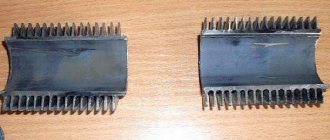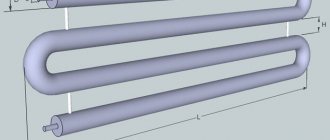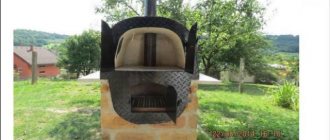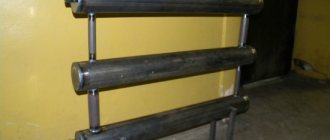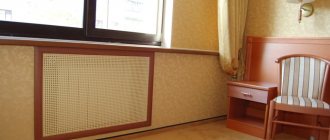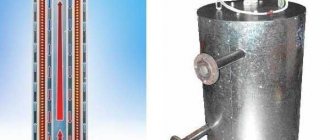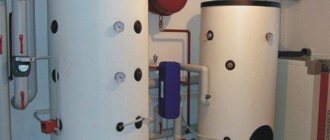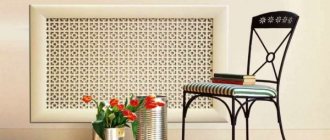How to calculate the heat transfer of heating registers made of smooth pipes? Many builders and designers face this question when selecting heating registers for a specific room. There are certain calculation methods, as well as special applications and programs, for example a heating register power calculator. We will consider them in our article.
One of the simplest and most accessible methods for calculating the heat transfer of registers is calculation in Excel. We have prepared a special document for you that allows you to make these calculations. Using the selected data as an example, we will calculate the heat transfer of a specific register.
Advantages and disadvantages
The advantages include simple design and simple calculations, availability of materials.
All this together allows you to make heating registers with your own hands. The next positive point is that most of the heat is transferred using radiant energy, and it is perceived by a person as more pleasant.
Heating registers are usually located in utility, production, and auxiliary rooms
The next plus is the smooth surface, which makes cleaning easy.
Excellent quality - compatibility with any systems - both natural and forced circulation.
Video description
An example of how to calculate heating in a private house using an online calculator in this video:
Selecting material for registers
The next parameter that must be taken into account when choosing a register is the material of its manufacture.
It is rare to see heating registers made from a profile pipe - most often steel products with a round cross-section are used for this.
Currently, several materials are used to produce registers - metal, aluminum or bimetallic pipes.
The difference between them lies in the calculated heat transfer and service life:
Steel heating registers made of profile pipe or round section. They are characterized by ease of manufacture and low cost. Disadvantage: surface rusting
When choosing, special attention should be paid to the quality of welds;
Aluminum. They are extremely rare, since welding aluminum heating registers requires special equipment
But they have better thermal conductivity. There is virtually no heat loss;
Bimetallic. They are made from a special type of heating pipes. They have a core made of steel. To increase the heating area, the design has copper or aluminum plate heat exchangers. All bimetallic heating registers are characterized by a small pipe diameter - up to 50 mm. Therefore, they are more often used to organize heat supply in residential buildings and small industrial and commercial premises.
Device characteristics
Heating registers have several qualities that distinguish them from other heating devices:
- Thanks to effective heat exchange with the surrounding space, small-sized devices are able to heat large rooms.
- Making a heat exchanger is quite simple - you only need a welding machine and an angle grinder with a cutting disc.
- You can use any available materials - pipes made of cast iron, stainless steel or steel.
- The devices are able to withstand high pressure (10 kgf/m2) and can operate on any coolant - water, oil, other liquids, steam.
- The device can be assembled either according to ready-made drawings or according to those drawn up independently. Various configuration options, plugs, additional elements and finishing materials are allowed.
- The final cost of a heat exchanger made of smooth pipes will be lower than that of other devices with a similar level of efficiency.
It is worth noting that the larger the total surface area of the device, the higher its heat transfer. In turn, the area depends on the cross-section of the pipe and the length of the section.
In most cases, heating registers have the following characteristics:
- Electric-welded carbon steel pipes are used for the heat exchanger.
- The pipes are connected in one of the following ways: flanged, external threaded, and welded.
- The maximum pressure value is 10 kgf/m2.
- The cross-section of pipes in sections is 32-219 mm.
- The minimum distance between levels is 50 mm.
- The cross-section of the connecting jumpers is from 32mm.
Bimetallic batteries
These radiators are made of a steel core inside and aluminum fins outside. The high strength of the batteries is achieved by the presence of steel inside. Most models are tested under pressure of 60 and even 150 atmospheres. They also have good chemical stability.
The high heat transfer of bimetallic radiators is due to aluminum fins with a significant surface area. Due to the small cross-section of the channels inside the sections, a high speed of coolant movement is ensured and there is no need for frequent flushing. The main disadvantage of bimetallic radiators is their high cost. Thus, a ten-section bimetallic battery will cost several times more than other options.
Gas heating
A double-circuit boiler is a very convenient device
Gas heating is one of the best today. Natural gas is an economical, efficient, safe, environmentally friendly fuel.
Gas and electric heating are similar in their efficiency, safety and a number of other advantages. But a detailed examination reveals its specific shortcomings.
A comparison with electric boilers reveals the following. Electric boilers are more expensive than gas boilers, but in some cases their performance is higher, control is more convenient and simpler, and their use is safer. An electric boiler only requires a power connection, while gas analogues additionally require the purchase of a mounted burner and regular cleaning of burning and soot. Electric boilers are easy to install, which is another advantage.
Gas heating requires permission to install it, prepare a site for its installation, lay out the system for it, connect and install all the necessary equipment, which in total is quite expensive. But the monthly heating fee will be lower than for electricity, although it also depends on the efficiency of the purchased gas system. Otherwise, the gas system has the disadvantages of a water system within the intra-house space, as a system that uses a coolant.
When comparing gas heating with heating by direct electric heaters, the advantages of electric heating are the absence of installation permission, much lower capital investments, and ease of installation and maintenance. The disadvantage is a more expensive source of energy - electric.
Calculation of registers from smooth pipes
Steel heating registers are easy to make with your own hands. The cost of such a heating system will depend on who will cook them. If you own the welding technique yourself, the option is the most low-budget; if the welder needs to be paid, there will not be much difference in cost with inexpensive aluminum ones.
Diameters, as mentioned, range from 32 mm to 100-150 mm. Large pipe sizes lead to an increase in system volume. When starting and accelerating the system, this is a minus - it will take quite some time until the coolant heats up. When working, a large volume is rather a plus: milder conditions for the boiler. On the other hand, with a large amount of coolant, it is difficult to regulate the temperature.
Table of heat transfer of steel pipes of different diameters for different operating conditions of the system (click on the picture to enlarge its size)
The distance between two pipes in the register should not be small: this reduces heat transfer. Therefore, they are located at a distance of no less than 1.5 radii. The number of rows and register length depend on the required power, as well as the diameter of the selected pipes. In the general case (for central Russia, for rooms with average thermal insulation and a ceiling height of 3 m), it can be calculated by the heat transfer of a meter of steel pipe. These values are given in the table. Using it you can find the size and number of registers by area of the room.
Heat transfer of one meter of steel pipes of different diameters - to calculate the heating register by area
To calculate the heat losses of a room, there are averaged data on the thermal power of a linear meter of steel pipe. You can use them for standard conditions. If the system operates at other temperatures, adjustments may need to be made up or down.
If these tables did not help you, you can calculate the register using the formula.
Formula for calculating registers made of steel pipes
By substituting the appropriate values, you will find the heat transfer of one pipe under your conditions. The heat transfer of all subsequent ones (second or more) will be slightly less. The found value must be multiplied by 0.9. So you will calculate and be able to make a register from smooth pipes with your own hands.
Reduced heat transfer.
In order to save energy, it becomes important to reduce the heat transfer of pipes in those sections of communications that are not used for their intended purpose, for example, when moving from one building to another or in an unheated room.
There are many options for using thermal insulation materials for this. Manufacturers offer a fairly wide range to choose from, ranging from cheap fiberglass to more expensive types of polystyrene foam. You can purchase pipes with insulating elements already built into them.
To summarize, we conclude that the use of such calculations helps to significantly save money and avoid many technical obstacles when designing water and heat supply systems.
Actually, you are a desperate person if you decide to undertake such an event. The heat transfer of a pipe, of course, can be calculated and there are a great many works on the theoretical calculation of the heat transfer of various pipes.
Let's start with the fact that if you decided to heat your house with your own hands, then you are a stubborn and purposeful person. Accordingly, a heating project has already been drawn up, pipes have been selected: either metal-plastic heating pipes or steel heating pipes. Heating radiators have also already been looked at in the store.
But, before acquiring all this, that is, at the design stage, it is necessary to make a conditional relative calculation. After all, the heat transfer of heating pipes, calculated in the project, is the key to warm winters for your family. There is no room for error here.
Methods for calculating heat transfer from heating pipes
Why is the emphasis usually placed on calculating the heat transfer of heating pipes? The fact is that for commercially manufactured heating radiators, all these calculations have been made and are given in the instructions for use of the products. Based on them, you can easily calculate the required number of radiators depending on the parameters of your home: volume, coolant temperature, etc.
Tables.
This is the quintessence of all the necessary parameters collected in one place. Today the Internet contains a great many tables and reference books for online calculations of heat transfer from pipes. In them you will learn what is the heat transfer of a steel pipe or cast iron pipe, the heat transfer of a polymer or copper pipe.
All that is needed when using these tables is to know the initial parameters of your pipe: material, wall thickness, internal diameter, etc. And, accordingly, enter into the search the query “Table of heat transfer coefficients of pipes.”
This section on determining the heat transfer of pipes also includes the use of manual reference books on heat transfer of materials. Although they are becoming more and more difficult to find, all information has migrated to the Internet.
Formulas.
The heat transfer of a steel pipe is calculated according to the formula
Qtr=1.163*Str*k*(Twater - Air)*(1-efficiency of pipe insulation), W where Str is the surface area of the pipe, and k is the heat transfer coefficient from water to air.
The heat transfer of a metal-plastic pipe is calculated using a different formula.
Where is the temperature on the inner surface of the pipeline, °C; t
c is the temperature on the outer surface of the pipeline, °C;
Q—
heat flow, W;
l
—pipe length, m;
t
—coolant temperature, °C;
t
inc—air temperature, °C;
a n is the external heat transfer coefficient, W/m 2 K; d
n - outer diameter of the pipe, mm;
l—thermal conductivity coefficient, W/m K; d
in
-
internal diameter of the pipe, mm; a int - internal heat transfer coefficient, W/m 2 K;
You understand perfectly well that calculating the thermal conductivity of heating pipes is a relative value. The formulas include the average parameters of certain indicators, which may, and do, differ from those that actually exist.
For example, as a result of the experiments, it was found that the heat transfer of a polypropylene pipe located horizontally is slightly lower than that of steel pipes of the same internal diameter, by 7-8%. It is internal, since polymer pipes have a slightly thicker wall thickness.
Many factors influence the final figures obtained in tables and formulas, which is why the footnote “approximate heat transfer” is always included. After all, the formulas do not take into account, for example, heat loss through the building envelope made of different materials. There are corresponding tables of amendments for this purpose.
However, by using one of the methods for determining the heat output of heating pipes, you will have a general idea of what kind of heating pipes and radiators you need for your home.
Good luck to you, builders of your warm present and future.
Type of heating boiler. Calculation of generated power
The boiler can be: gas, electric, solid fuel, combined, etc. The choice of boiler often depends on the fuel that prevails in the region of residence.
- A gas boiler
. To install such a boiler, a separate room (boiler room) was previously required. Now this only applies to boilers with an open combustion chamber. This type of heating boiler is most common in gasified areas. - Electric boiler
. It has not become widespread due to the high cost of electricity and problems with connecting power. - Solid fuel boiler
. It is not very popular given the relative availability of fuel. This is due to a number of inconveniences during its operation. For example, it is necessary to fire the fire several times during the day. Also, the heat transfer mode is cyclical. The use of this type of boiler is facilitated (by reducing the number of fireboxes) due to the use of fuel with a high calorific value or a thermal cylinder, which increases the combustion time due to controlled air supply; this can also be done through water heat accumulators connected to the heating system.
Determining parameters when calculating power
- Area of the heated room (S);
- Specific boiler power per room area of 10 m², taking into account the climatic conditions of the region (Wsp).
Existing generally accepted values of specific power depending on the climatic zone:
- Northern regions: Wsp = 1.5 – 2.0 kW;
- Central regions: Wud = 1.2 – 1.5 kW;
- Southern regions: Wsp = 0.7 – 0.9 kW;
Formula for calculating boiler power
Wcat = S. Wud/10
Taking for the convenience of calculations the average value of Wsp per unit (1 kW), we obtain the above-mentioned value of 10 kW per 100 m² of heated area.
The type of water heating depends on the size of the house. A natural circulation system is suitable for an area of no more than 100 m².
In other cases, forced circulation of the coolant (hot water) is used through circulation pumps.
Calculation of the required number of registers in the house
When choosing registers for heating, you need to pay special attention to the pipes used in the design and their diameter. The most suitable option for this parameter is considered to be a size of 31-32 mm
Experts do not recommend installing registers from pipes whose diameter exceeds 82 mm. This is due to the fact that heating boilers will not be able to provide the required amount of coolant.
In terms of heat transfer, aluminum radiators are better than steel ones.
For each individual building, it is necessary to very accurately determine the number of pipes and their diameter in the register. Therefore, installing these heating systems in a house requires taking into account the following factors:
- The number of doors and windows in the building.
- Wall thickness.
- Materials from which windows and doors are made.
To calculate the required number of pipes, one main indicator should be taken into account - the heat transfer of 1 m of pipeline. The cost of installing a heating system using radiators and registers is not much different. The differences in price depend only on the number of joints, the cost of welding work and pipes, and the size of the devices. In multi-story and one-story buildings, it is best to use registers for lower pipe routing.
We calculate the return for 1 m of product
It is easy to calculate the heat transfer of 1 m of pipe made of steel. We have a formula, all we have to do is substitute the values.
Q = 0.047*10*60 = 28 W.
- K = 0.047, heat transfer coefficient;
- F = 10 m2, pipe area;
- dT = 60° C, temperature difference.
It's worth remembering
Do you want to make a heating system correctly? You should not select pipes by eye. Heat transfer calculations will help optimize construction costs. In this case, you can get a good heating system that will last for many years.
The thermal conductivity of steel is quite high - this is a law of physics, and one cannot argue with it. But you can turn this property of metal to your advantage. It is this heat transfer that allows steel to be used in the production of various devices for heating rooms.
Algorithm for performing installation work
The installation of a two-pipe associated heating system is carried out in accordance with a certain algorithm, where the initial stage is the selection of pipe diameters, and the final stage is the installation of a circulator pump.
Calculation of pipeline diameter
There is a scientifically based method of calculation. The cross-section of the pipe is selected based on the volume of coolant passing through the pipe per unit time. The calculation starts from the distant radiator using the formula:
G=3600×Q/(c×Δt), (1)
where: G – water consumption for heating the house (kg/h);
Q is the thermal power required for heating (kW);
c – heat capacity of water (4.187 kJ/kg×°C);
Δt is the temperature difference between the hot and cold coolant, taken equal to 20 °C.
Next, calculate the cross-section of the pipes using the formula:
S=GV/(3600×v), (2)
where: S is the cross-sectional area of the pipe (m2);
GV – volumetric water flow (m3/h);
v is the speed of water movement, is in the range of 0.3−0.7 m/s.
The resulting figure is the cross-section; based on it, the internal diameter of the pipeline is selected.
This calculation is carried out for all radiators up to the boiler.
When calculating, you can also rely on the table of the dependence of the internal diameter of the pipe on the thermal load.
Table of dependence of the internal diameter of the pipe on the thermal load
The following guidelines can be taken into account:
- For heat losses of up to 15 kW (150 sq. m.) of area, pipes with a diameter of 20 mm are suitable.
- For losses from 15 to 27 kW (up to 250 square meters), pipes with a diameter of at least 25 mm will be required.
Carrying out calculations using the given formulas or hydraulic tables is a difficult task for the homeowner, so you can rely on the recommended pipe diameters.
The diameter of the pipeline must be the same throughout its entire length to ensure stable operation of the batteries. The recommended minimum internal diameter of pipes is 20 mm.
The following conditions must be met:
- Place pipes under the floor covering to avoid high-rise contours. If this is not possible, then you need to take into account the configuration of the house and strive as much as possible for the same height of pipe laying.
- Pipe material is metal-plastic or polypropylene reinforced with aluminum foil. Such pipes are stronger and will last a long time.
- Radiators are installed bimetallic or steel with a bottom connection system. Such batteries have higher hydraulic resistance, which balances the system. The power of the radiators should be the same throughout the entire area of the house.
- Each battery is equipped with a balancing valve on the return line. It is advisable to install thermostats.
Boiler installation
The room where the boiler is installed must have a height of at least 2.5 m. The volume of the room is recommended from 8 cubic meters. The hot water boiler must be selected depending on the area of the heated house. Boiler power for heating is 10 kW. m is equal to 1 kW. Based on this, the power for the entire system is selected.
The boiler piping consists of a set of shut-off valves; it is installed in several places:
- On the make-up pipe.
- On both sides of the pump.
- At the expansion tank.
- On the pipes coming from the boiler.
Mainline pulling
When installing the associated heating system distribution line, the following must be taken into account:
- The outlet branch of the main line must be located below the supply branch.
- The heat supply and heat removal pipes must be parallel to each other.
- The expansion tank must be installed above the heating boiler.
- Valves for draining water must be installed on the connecting radiators. It is recommended to install a thermostatic head on each radiator to ensure a comfortable temperature.
- When laying the pipeline, right angles are excluded to avoid the occurrence of air locks in the system.
- The expansion tank must be installed in a heated room.
- All diameters of pipes, fittings and taps must match each other. You cannot install pipes of different diameters in an attempt to save money. The water pressure in the system will be disrupted.
Installing a circulation pump
It is unreasonable to rely on natural circulation, since there are 10 or more batteries in the associated heating system. Gravity will not be able to work without forced pressure. The circulation pump is installed on the return branch near the boiler. The pump is installed using a bypass and three valves. It is recommended to install a filter.
A circulation pump is installed on each floor
The associated heating system is installed in one-story and two-story buildings. In two-story buildings, during installation you need to take into account some nuances:
- A circulation pump is installed on each floor. If a breakdown occurs on one floor, the heating will work fully on the other.
- For each floor it is recommended to install according to a separate scheme.
Kinds
There are two types of these devices:
- Elevators that cannot be regulated.
- Elevators, the operation of which is controlled by an electric drive.
When installing any of them, it is very important to maintain tightness. This equipment is installed in a heating system that is already functioning
Therefore, before installation, it is recommended to study the location where the subsequent placement of this equipment is planned. It is recommended to entrust this type of work to specialists who are able to understand the scheme, as well as develop drawings and perform calculations.
Flat-plate heat exchanger
A popular option, which is used both for stoves in the bathhouse and for the home. They are the simplest to manufacture, the surface is easy to clean from soot accumulations, installation is possible both vertically and horizontally, and the efficiency is relatively high.
A flat boiler can have a high volume, so you can take hot water for washing directly from the heating system. An expansion tank with an increased linear size is installed, into which water constantly flows after the level drops below critical. This option is quite convenient and helps solve several problems at once, but there is also a condition - the room temperature in winter should not drop to minus.
Key disadvantage: a sharp decrease in heat transfer from the furnace walls. This type of heat exchanger is made in the shape of the letter “P” and is installed around the perimeter of the firebox, bypassing the door. As a result, it turns out that the temperature of the external walls is quite low, as a result, warming up the room takes much longer. This is critical only if the stove is installed in a bathhouse; for residential buildings, where the stove is constantly heated, increasing the warm-up time by several hours does not play any role.
Thus, when choosing a flat boiler, think about how you can increase the heating rate. One option is to enlarge the heater and place it directly above the firebox. Second option: using a metal chimney for heating, increasing its length.
How to make a homemade heat exchanger
Multi-pipe register
The shape of a heat exchanger for heating made by yourself can be different. The most common option is a register made of several steel or copper pipes, but plate-type examples are also used.
The temperature in the combustion zone is very high, especially when burning coal. Therefore, increased demands are placed on the metal from which the heat exchanger elements will be made, the rationality of its design and the quality of the welds.
Materials for production
An example of using cast iron radiators as a heat exchanger in a brick oven
The task of water heat exchangers for heating is to ensure optimal heat transfer, and in this process the degree of thermal conductivity of the metal is important. For example, a steel pipe conducts heat 7 times less than a copper pipe. Therefore, with the same pipe diameter, to transfer the same amount of heat, you will need 25 meters of steel pipe instead of 3.5 meters of copper.
Copper heat exchangers are the most economical to operate, but also expensive. Heat exchangers made of steel pipes with a diameter of at least 32 mm are considered more affordable for self-production.
If you plan to heat the stove with coal, it is better to install a heat exchanger made of cast iron. This metal is stronger, and the walls of the device will not burn out for a long time.
Heat exchanger power calculation
It is quite difficult to calculate in advance the power of the heat exchanger for a heating system. To do this, you need to take into account too many factors: pipe diameter, coil length, thermal conductivity of the metal, fuel combustion temperature, coolant circulation rate, etc. The real ability of the heat exchanger to cope with its functions will become clear only after the heating system starts operating.
When calculating, you can estimate that 1 meter of pipe with a diameter of 50 mm, serving as a heat exchanger, will provide 1 kW of thermal power.
You can take as an example any well-known boiler model and, in accordance with its parameters, make your own homemade heat exchanger.
Design Features
A heat exchanger for water heating of a house, welded from smooth-walled pipes, is called a register. It looks like a kind of “grid” and is the most popular form of homemade heat exchanger. In addition to this design, simpler devices are also made in the form of a rectangular or cylindrical tank. The main thing is that the surface area for heat exchange is as large as possible.
When making a heat exchanger with your own hands, several conditions must be observed:
- the width of the internal voids in the heat exchanger must be at least 5 mm, otherwise the water in it may boil;
- the thickness of the pipe walls must be at least 3 mm so that the metal does not burn through;
- a gap of 10–15 mm between the heat exchanger and the walls of the firebox should compensate for the expansion of the metal when heated.
Installation features
The heat exchanger is installed inside the furnace during its laying
The easiest way is to install the heat exchanger simultaneously with the construction of the furnace. If you install it in an old stove, you will have to dismantle part of its brickwork.
- A tubular heat exchanger is installed on the prepared furnace foundation directly into the furnace cavity.
- When further laying rows of bricks, space is left for the inlet and outlet pipes of the device.
- After completing the laying of the stove, connect the heat exchanger to the heating system, fill the system with water and test fire the stove.
The video material offers useful tips for making a heat exchanger yourself:
So far we have only talked about heat exchangers in a water heating system
Let's pay attention to other areas of their application.
Using cross-linked polyethylene for heated floors
Metal-plastic is very convenient as a material for a pipeline that will be hidden under your floor and will have to warm the feet of you and your family. Metal-plastic is multi-layered, so it is not susceptible or minimally susceptible to corrosion, lasts more than fifty years, the pipes have a large footage (from 50 to 500 meters), in addition, they have low linear elongation when heated.
Connections can be detachable, conditionally detachable and permanent. Detachable fittings include threaded and collet fittings; for conditionally detachable ones - compression ones, and for non-detachable ones - press fittings. Of course, it is necessary to buy both the pipes themselves and fittings only from reliable and trusted manufacturers.
Metal-plastic floor pipes have many advantages, but they also have some disadvantages. These disadvantages can be very significant if you are not warned about them in advance.
So, firstly, due to the different expansion coefficients of the polymer and aluminum, spontaneous expansion may occur and/or the pipes may crack (a phenomenon that professionals call pipe delamination will occur). Secondly, if you use threaded fittings for installation, then scale may form on their inside. Therefore, it is better to use exclusively press fittings (of course, when possible).
Despite a number of significant disadvantages, today metal-plastic pipes for floor heating are the best and most used option for those who value comfort, long service life of the product, as well as their own safety and the safety of their family. They have good thermal conductivity and have multiple advantages.
Typology of heating registers
Depending on the design, heating registers are divided into two types:
- Sectional. This type of heating product consists of several parallel smooth pipes with plugs, which are connected to each other by short pipes of smaller diameter. Sections can be made from smooth pipes of different diameters. The register inlet can be threaded or flanged. Short transition pipes should be located as close to the ends of the pipe as possible, this affects the amount of heat transferred.
- Serpentine. This type of registers consists of sections of smooth pipe, which are connected to each other by arcs. In this type of registers, heat transfer is significantly improved, since the entire surface of the pipe is involved in heating. In addition, the design of coil registers eliminates the presence of transition sections, which significantly reduces pressure drops within the system.
We make a calculation
The formula by which heat transfer is calculated is as follows:
Q = K*F*dT, where
- K – thermal conductivity coefficient of steel;
- Q – heat transfer coefficient, W;
- F is the area of the pipe section for which the calculation is being made, m 2 dT is the value of the temperature pressure (the sum of the primary and final temperatures taking into account room temperature), ° C.
The thermal conductivity coefficient K is selected taking into account the area of the product. Its size also depends on the number of threads laid in the premises. On average, the coefficient is in the range of 8-12.5.
dT is also called temperature difference. To calculate the parameter, you need to add the temperature that was at the outlet of the boiler with the temperature that was recorded at the entrance to the boiler. The resulting value is multiplied by 0.5 (or divided by 2). The room temperature is subtracted from this value.
dT = (0.5*(T 1 + T 2)) - T to
If the steel pipe is insulated, then the resulting value is multiplied by the efficiency of the insulating material. It reflects the percentage of heat that was given off during the passage of the coolant.
Features of device operation
If you plan to use copper radiators in your heating system, you must comply with certain requirements and rules regarding not only installation, but also the operation process. For example, manufacturers do not advise installing several copper and steel devices simultaneously along the flow of the working fluid, as this can lead to a certain electrochemical reaction that can destroy the entire system.
Note! If you cannot refuse this combined option, then be sure to use brass fittings for the connection. Today, these are sold in almost any specialized store, the assortment is huge, and the cost is quite affordable.
It is also undesirable to install copper devices in those lines that may contain small abrasive particles - the latter will, over time, “undermine” the material and sooner or later lead to wear of the radiators.
Finally, do not install such batteries if the operating fluid is very hard or highly acidic. Although some of these difficulties can be solved by installing additional special filters.
Video - Installing a copper battery
What are there
Heating registers are made of different materials and have different shapes. Each has pros and cons.
What are they made from?
If we talk about materials, the most common is steel, or rather electric-welded steel pipes. Steel does not have the best heat transfer, but this is compensated by its low price, ease of processing, availability and a large selection of standard sizes.
It is very rare to find pipes made of stainless steel - for decent power a large number of pipes are required, and you have an idea how much stainless steel products cost. If they did, it was probably a long time ago. They also use galvanized steel, but it is more difficult to work with - you won’t be able to cook it.
- Requires neutral and clean coolant, free of solid particles
- the presence of other metals and alloys in the system is undesirable, except for compatible ones - bronze, brass, nickel, chromium, therefore all fittings and fittings will need to be made from these materials;
- Careful grounding is mandatory - without it, in the presence of water, electrochemical corrosion processes begin;
- the softness of the material requires protection - covers are needed, etc.
There are registers made of cast iron. But they are too bulky. In addition, they have a very large mass; no less massive racks need to be made for them. Plus, cast iron is fragile - one blow and it can crack. It turns out that this type of registers also needs protective covers, and they reduce heat transfer and increase cost. Moreover, installing them is complex and hard work. The advantages include high reliability and chemical neutrality: this alloy does not care what coolant it works with.
In general, copper and cast iron are not easy. So it turns out that the optimal choice is steel registers.
Heater design calculation
First you need to calculate the required heating power for a specific room.
According to the rules, such a thermal calculation should be done taking into account:
- area and orientation of external walls (in the southern sunny direction or not);
- cubic capacity of the heated room;
- the level of maximum possible negative temperatures in the region;
- degree of thermal insulation of walls facing the street;
- the presence of another heated room below and/or above;
- quantities, sizes and types of windows installed;
- presence/absence of doors opening directly to the street.
Building codes even recommend taking into account the prevailing wind rose in winter. On the windward side near the wall, heat loss during the winter period will obviously be higher.
Simplified, for a room with a ceiling height of around 2.7 meters, the required thermal power is calculated by multiplying the area of the room by 100 W
If the ceilings in the room are located at a level of 3 meters or higher, then for a simplified calculation the cubic capacity of the heated space should be multiplied by 34 or 41 W. The first coefficient is taken for brick buildings, and the second for reinforced concrete buildings.
Multiplying a couple of numbers is not difficult. But we must be clearly aware that such conditional calculations can be very far from real figures, since there are many nuances here.
The best way out is to order the required calculation from a specialist who will take into account all the parameters of the room. Heat loss occurs through walls, windows, floors, ceilings and even ventilation
To obtain accurate numbers, everything must be taken into account without exception.
Next, you need to calculate the dimensions of the pipes for the heating register. To do this, use the formula:
Q= K* St*dt
letter designations:
- Q – thermal power of the register;
- K – heat transfer coefficient, depends on the pipe material;
- St – heat transfer area (equal to the number PI multiplied by the diameter and length of the pipe);
- dt – thermal pressure.
Accordingly, knowing Q and dt, all that remains is to select the diameter of the pipe and its total length. Then, depending on the design of the register, this pipeline can be divided into several sections, which will subsequently be connected by crossbars. In order not to complicate the calculations, it is better not to take into account the heat transfer from the latter.
The dt figure, in turn, is calculated based on the required room temperature (Tv) and its indicators in the supply (Tp) and return (To) - total dt = (Tp+To)/2-Tv
When connecting pipes with a snake, each subsequent horizontal segment receives approximately 10% less thermal energy than the one located above. Each such section of the register pipeline should be considered as a separate battery. And as the coolant moves through them, it gradually and inevitably cools down, and the heat goes into the room.
Another parameter is the distance between the horizontal sections (main pipes), which reflects the height of the individual pipe. If this gap is made too small, then the heat flows from above and below will begin to overlap, negatively affecting each other.
This figure must be selected so that it is slightly larger than the diameter of the pipe. Then the efficiency of the register will be maximum possible.
More detailed calculations of the power of heating batteries and their quantity can be read here.
Adviсe
Before you start making registers, you should take care of purchasing the appropriate materials. You will need pipes of one diameter or another and some length. Exact numbers are not given here, since the device of the type in question can be assembled from any pipes without focusing on their diameter and thickness
More important is to ensure optimal heat transfer, which involves carrying out calculations regarding the required surface area of the register
To do this, you will need to determine the outer area of the entire system. The resulting value is then multiplied by 330 W. The use of this method is based on the statement that 1 m2 gives off 330 W of heat if the temperature of the medium is 60 °C and the air inside the heated room is 18 °C.
For people skilled in welding, assembling the structure will not be difficult. It will be necessary to prepare pipes and cut them into sections, and also take care of the plugs, for the manufacture of which a steel sheet will be required. Register assembly does not imply the presence of a strictly defined order of actions. Upon completion of welding work, it is necessary to ensure the tightness of the created structure. Otherwise, the following advice can be given:
- you should select pipes with an optimal wall thickness, since too thin ones cool quickly enough, and thick ones take a long time to warm up;
- the upper section must be supplemented with a Mayevsky valve, with the help of which air is released;
- assembly of the register in the form of a coil involves the use of a pipe bender; if this is not possible, the rotary sections can be assembled from ready-made elbows;
- the coolant inlet must be equipped with a tap, and the outlet with a valve;
- The installation of the register should be carried out with a slight slope in the direction where the supply pipe is located, which ensures that the Mayevsky crane occupies the highest position.
